A Study of Project Management and Leadership at BBC Broadcasting House
VerifiedAdded on 2022/09/09
|5
|1320
|16
Report
AI Summary
This report examines the project management aspects of the BBC Broadcasting House renovation, focusing on leadership styles and team development throughout the project's two phases. The analysis delves into the team development cycle, highlighting the importance of understanding cultural differences and the impact of leadership on project success. The report explores the challenges faced, such as the dismissal of the initial architect, and the significance of selecting appropriate team members. It also discusses the advantages and disadvantages of online collaboration in project management. Furthermore, the report underscores the importance of strong leadership that combines managerial and leader qualities. The author reflects on their experience, emphasizing the value of team collaboration and effective communication to achieve project goals. The project's budget and timeline are also briefly discussed as well as how value engineering was used to cut costs.
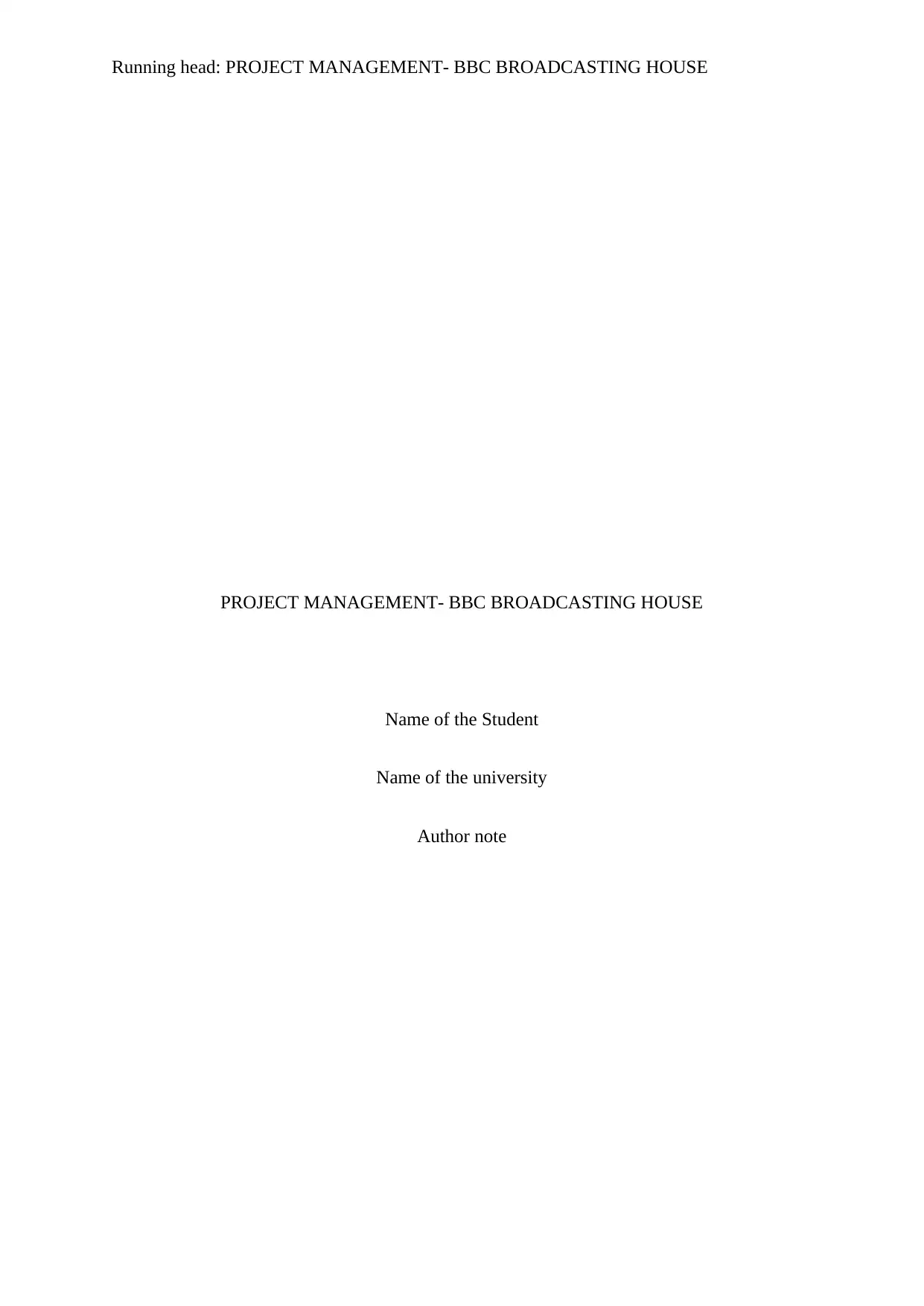
Running head: PROJECT MANAGEMENT- BBC BROADCASTING HOUSE
PROJECT MANAGEMENT- BBC BROADCASTING HOUSE
Name of the Student
Name of the university
Author note
PROJECT MANAGEMENT- BBC BROADCASTING HOUSE
Name of the Student
Name of the university
Author note
Paraphrase This Document
Need a fresh take? Get an instant paraphrase of this document with our AI Paraphraser
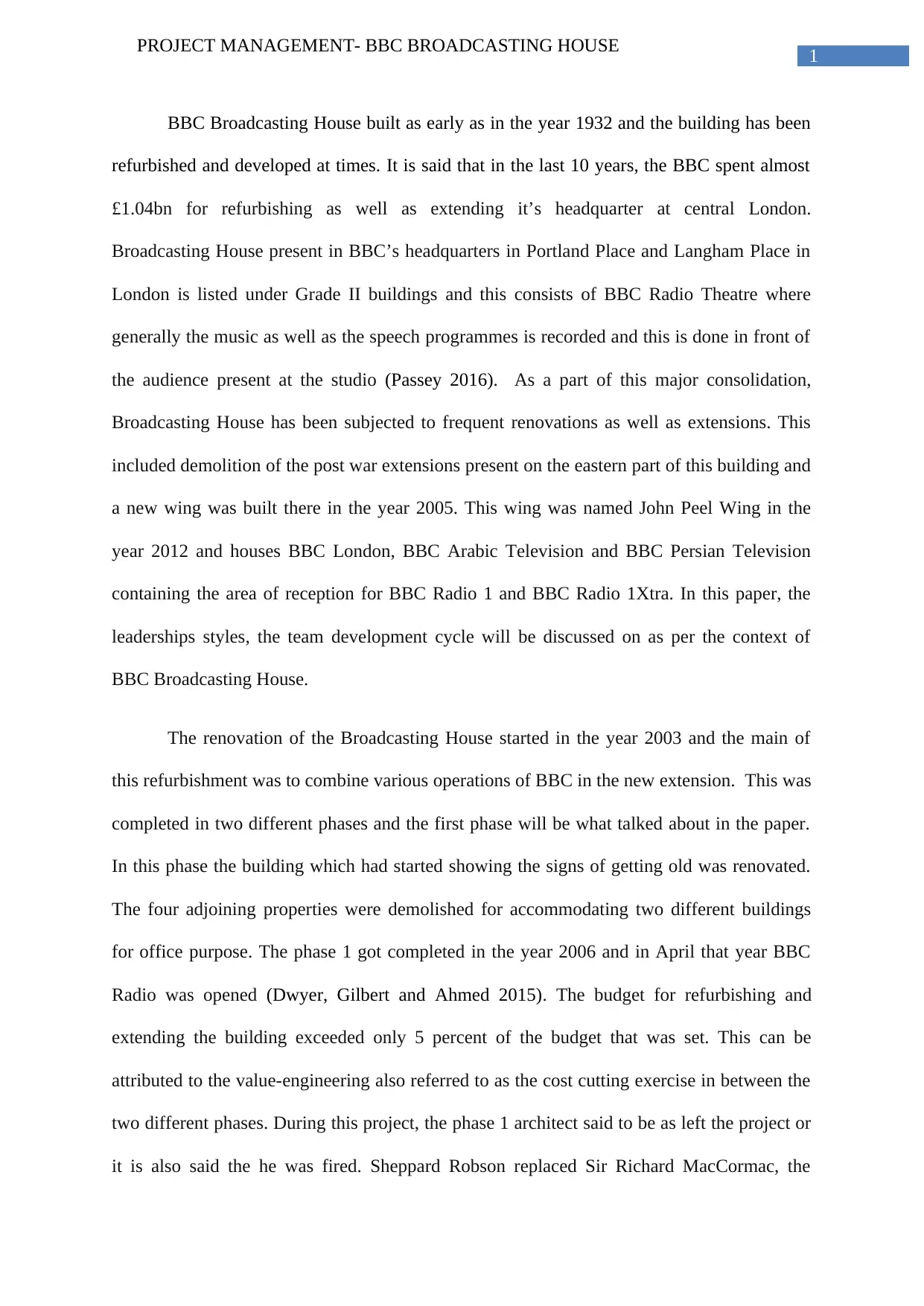
1
PROJECT MANAGEMENT- BBC BROADCASTING HOUSE
BBC Broadcasting House built as early as in the year 1932 and the building has been
refurbished and developed at times. It is said that in the last 10 years, the BBC spent almost
£1.04bn for refurbishing as well as extending it’s headquarter at central London.
Broadcasting House present in BBC’s headquarters in Portland Place and Langham Place in
London is listed under Grade II buildings and this consists of BBC Radio Theatre where
generally the music as well as the speech programmes is recorded and this is done in front of
the audience present at the studio (Passey 2016). As a part of this major consolidation,
Broadcasting House has been subjected to frequent renovations as well as extensions. This
included demolition of the post war extensions present on the eastern part of this building and
a new wing was built there in the year 2005. This wing was named John Peel Wing in the
year 2012 and houses BBC London, BBC Arabic Television and BBC Persian Television
containing the area of reception for BBC Radio 1 and BBC Radio 1Xtra. In this paper, the
leaderships styles, the team development cycle will be discussed on as per the context of
BBC Broadcasting House.
The renovation of the Broadcasting House started in the year 2003 and the main of
this refurbishment was to combine various operations of BBC in the new extension. This was
completed in two different phases and the first phase will be what talked about in the paper.
In this phase the building which had started showing the signs of getting old was renovated.
The four adjoining properties were demolished for accommodating two different buildings
for office purpose. The phase 1 got completed in the year 2006 and in April that year BBC
Radio was opened (Dwyer, Gilbert and Ahmed 2015). The budget for refurbishing and
extending the building exceeded only 5 percent of the budget that was set. This can be
attributed to the value-engineering also referred to as the cost cutting exercise in between the
two different phases. During this project, the phase 1 architect said to be as left the project or
it is also said the he was fired. Sheppard Robson replaced Sir Richard MacCormac, the
PROJECT MANAGEMENT- BBC BROADCASTING HOUSE
BBC Broadcasting House built as early as in the year 1932 and the building has been
refurbished and developed at times. It is said that in the last 10 years, the BBC spent almost
£1.04bn for refurbishing as well as extending it’s headquarter at central London.
Broadcasting House present in BBC’s headquarters in Portland Place and Langham Place in
London is listed under Grade II buildings and this consists of BBC Radio Theatre where
generally the music as well as the speech programmes is recorded and this is done in front of
the audience present at the studio (Passey 2016). As a part of this major consolidation,
Broadcasting House has been subjected to frequent renovations as well as extensions. This
included demolition of the post war extensions present on the eastern part of this building and
a new wing was built there in the year 2005. This wing was named John Peel Wing in the
year 2012 and houses BBC London, BBC Arabic Television and BBC Persian Television
containing the area of reception for BBC Radio 1 and BBC Radio 1Xtra. In this paper, the
leaderships styles, the team development cycle will be discussed on as per the context of
BBC Broadcasting House.
The renovation of the Broadcasting House started in the year 2003 and the main of
this refurbishment was to combine various operations of BBC in the new extension. This was
completed in two different phases and the first phase will be what talked about in the paper.
In this phase the building which had started showing the signs of getting old was renovated.
The four adjoining properties were demolished for accommodating two different buildings
for office purpose. The phase 1 got completed in the year 2006 and in April that year BBC
Radio was opened (Dwyer, Gilbert and Ahmed 2015). The budget for refurbishing and
extending the building exceeded only 5 percent of the budget that was set. This can be
attributed to the value-engineering also referred to as the cost cutting exercise in between the
two different phases. During this project, the phase 1 architect said to be as left the project or
it is also said the he was fired. Sheppard Robson replaced Sir Richard MacCormac, the
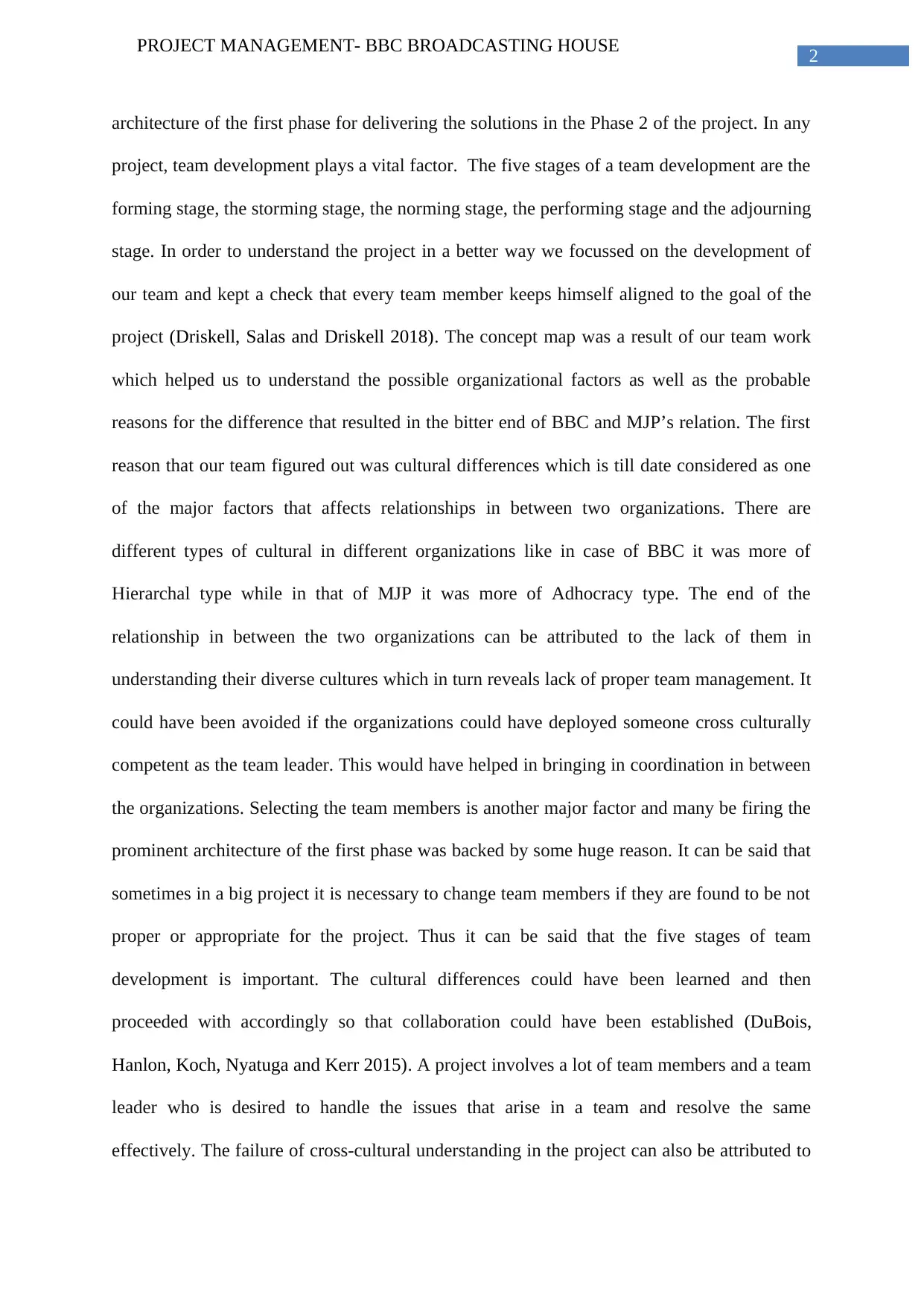
2
PROJECT MANAGEMENT- BBC BROADCASTING HOUSE
architecture of the first phase for delivering the solutions in the Phase 2 of the project. In any
project, team development plays a vital factor. The five stages of a team development are the
forming stage, the storming stage, the norming stage, the performing stage and the adjourning
stage. In order to understand the project in a better way we focussed on the development of
our team and kept a check that every team member keeps himself aligned to the goal of the
project (Driskell, Salas and Driskell 2018). The concept map was a result of our team work
which helped us to understand the possible organizational factors as well as the probable
reasons for the difference that resulted in the bitter end of BBC and MJP’s relation. The first
reason that our team figured out was cultural differences which is till date considered as one
of the major factors that affects relationships in between two organizations. There are
different types of cultural in different organizations like in case of BBC it was more of
Hierarchal type while in that of MJP it was more of Adhocracy type. The end of the
relationship in between the two organizations can be attributed to the lack of them in
understanding their diverse cultures which in turn reveals lack of proper team management. It
could have been avoided if the organizations could have deployed someone cross culturally
competent as the team leader. This would have helped in bringing in coordination in between
the organizations. Selecting the team members is another major factor and many be firing the
prominent architecture of the first phase was backed by some huge reason. It can be said that
sometimes in a big project it is necessary to change team members if they are found to be not
proper or appropriate for the project. Thus it can be said that the five stages of team
development is important. The cultural differences could have been learned and then
proceeded with accordingly so that collaboration could have been established (DuBois,
Hanlon, Koch, Nyatuga and Kerr 2015). A project involves a lot of team members and a team
leader who is desired to handle the issues that arise in a team and resolve the same
effectively. The failure of cross-cultural understanding in the project can also be attributed to
PROJECT MANAGEMENT- BBC BROADCASTING HOUSE
architecture of the first phase for delivering the solutions in the Phase 2 of the project. In any
project, team development plays a vital factor. The five stages of a team development are the
forming stage, the storming stage, the norming stage, the performing stage and the adjourning
stage. In order to understand the project in a better way we focussed on the development of
our team and kept a check that every team member keeps himself aligned to the goal of the
project (Driskell, Salas and Driskell 2018). The concept map was a result of our team work
which helped us to understand the possible organizational factors as well as the probable
reasons for the difference that resulted in the bitter end of BBC and MJP’s relation. The first
reason that our team figured out was cultural differences which is till date considered as one
of the major factors that affects relationships in between two organizations. There are
different types of cultural in different organizations like in case of BBC it was more of
Hierarchal type while in that of MJP it was more of Adhocracy type. The end of the
relationship in between the two organizations can be attributed to the lack of them in
understanding their diverse cultures which in turn reveals lack of proper team management. It
could have been avoided if the organizations could have deployed someone cross culturally
competent as the team leader. This would have helped in bringing in coordination in between
the organizations. Selecting the team members is another major factor and many be firing the
prominent architecture of the first phase was backed by some huge reason. It can be said that
sometimes in a big project it is necessary to change team members if they are found to be not
proper or appropriate for the project. Thus it can be said that the five stages of team
development is important. The cultural differences could have been learned and then
proceeded with accordingly so that collaboration could have been established (DuBois,
Hanlon, Koch, Nyatuga and Kerr 2015). A project involves a lot of team members and a team
leader who is desired to handle the issues that arise in a team and resolve the same
effectively. The failure of cross-cultural understanding in the project can also be attributed to
⊘ This is a preview!⊘
Do you want full access?
Subscribe today to unlock all pages.

Trusted by 1+ million students worldwide
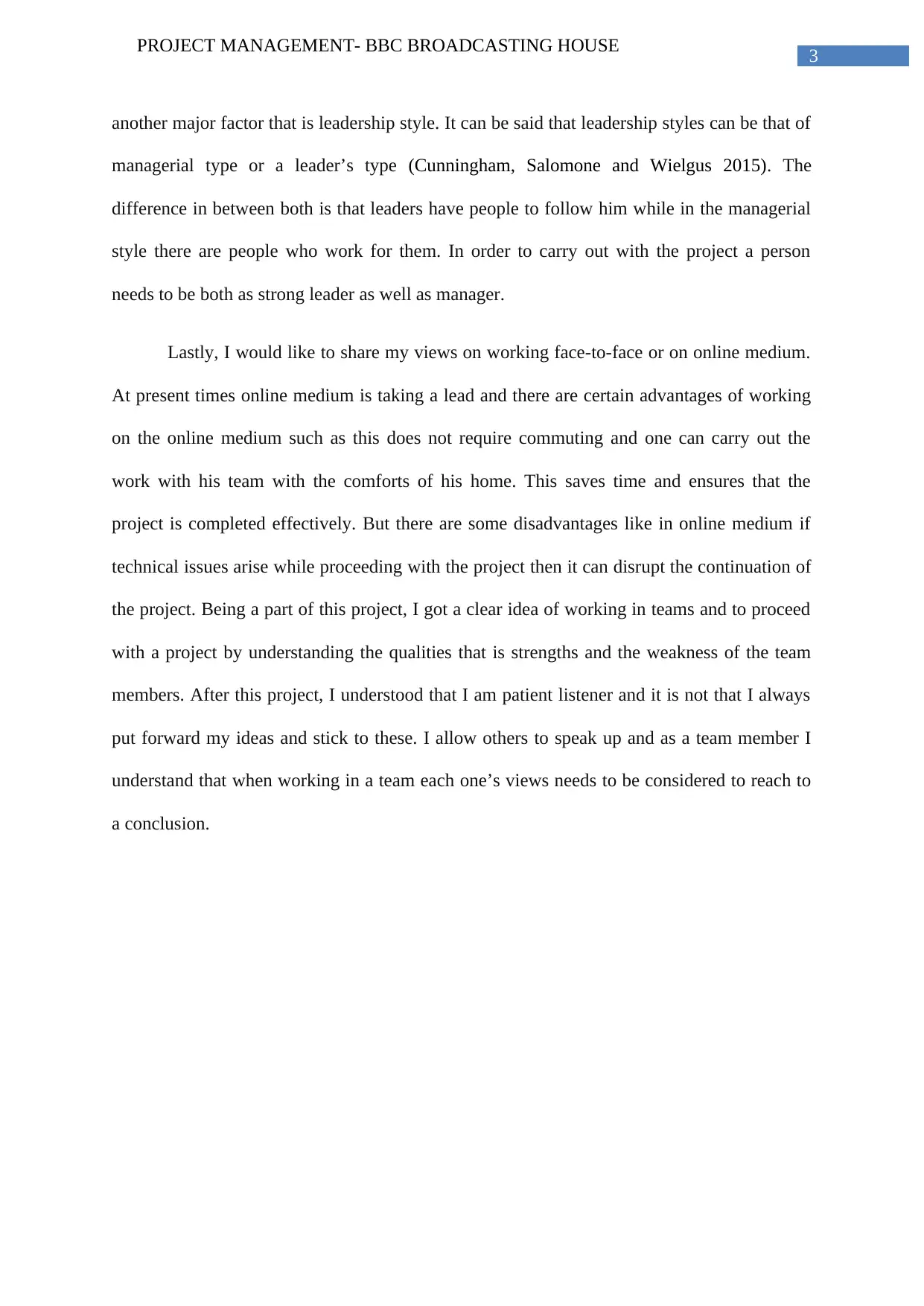
3
PROJECT MANAGEMENT- BBC BROADCASTING HOUSE
another major factor that is leadership style. It can be said that leadership styles can be that of
managerial type or a leader’s type (Cunningham, Salomone and Wielgus 2015). The
difference in between both is that leaders have people to follow him while in the managerial
style there are people who work for them. In order to carry out with the project a person
needs to be both as strong leader as well as manager.
Lastly, I would like to share my views on working face-to-face or on online medium.
At present times online medium is taking a lead and there are certain advantages of working
on the online medium such as this does not require commuting and one can carry out the
work with his team with the comforts of his home. This saves time and ensures that the
project is completed effectively. But there are some disadvantages like in online medium if
technical issues arise while proceeding with the project then it can disrupt the continuation of
the project. Being a part of this project, I got a clear idea of working in teams and to proceed
with a project by understanding the qualities that is strengths and the weakness of the team
members. After this project, I understood that I am patient listener and it is not that I always
put forward my ideas and stick to these. I allow others to speak up and as a team member I
understand that when working in a team each one’s views needs to be considered to reach to
a conclusion.
PROJECT MANAGEMENT- BBC BROADCASTING HOUSE
another major factor that is leadership style. It can be said that leadership styles can be that of
managerial type or a leader’s type (Cunningham, Salomone and Wielgus 2015). The
difference in between both is that leaders have people to follow him while in the managerial
style there are people who work for them. In order to carry out with the project a person
needs to be both as strong leader as well as manager.
Lastly, I would like to share my views on working face-to-face or on online medium.
At present times online medium is taking a lead and there are certain advantages of working
on the online medium such as this does not require commuting and one can carry out the
work with his team with the comforts of his home. This saves time and ensures that the
project is completed effectively. But there are some disadvantages like in online medium if
technical issues arise while proceeding with the project then it can disrupt the continuation of
the project. Being a part of this project, I got a clear idea of working in teams and to proceed
with a project by understanding the qualities that is strengths and the weakness of the team
members. After this project, I understood that I am patient listener and it is not that I always
put forward my ideas and stick to these. I allow others to speak up and as a team member I
understand that when working in a team each one’s views needs to be considered to reach to
a conclusion.
Paraphrase This Document
Need a fresh take? Get an instant paraphrase of this document with our AI Paraphraser
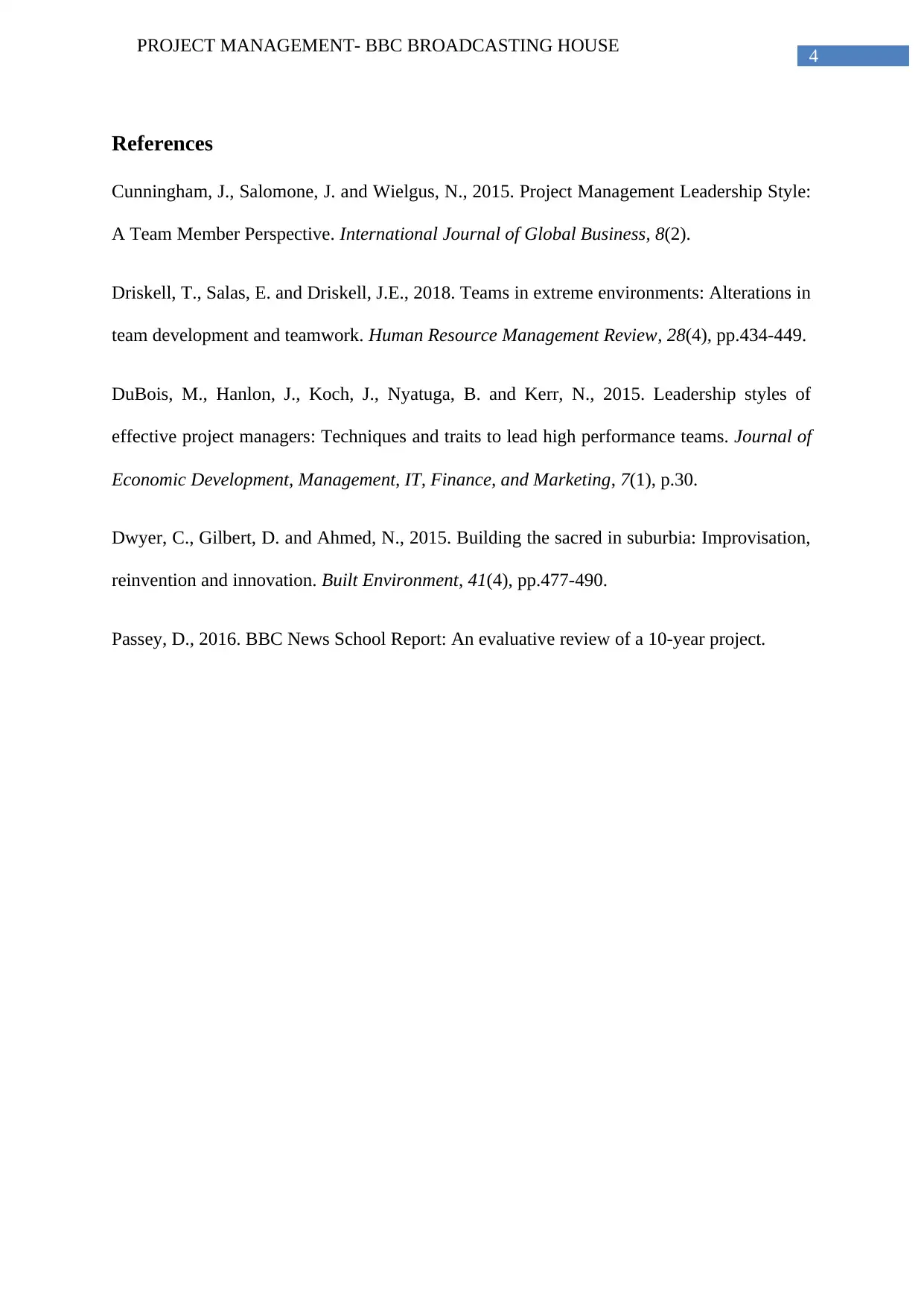
4
PROJECT MANAGEMENT- BBC BROADCASTING HOUSE
References
Cunningham, J., Salomone, J. and Wielgus, N., 2015. Project Management Leadership Style:
A Team Member Perspective. International Journal of Global Business, 8(2).
Driskell, T., Salas, E. and Driskell, J.E., 2018. Teams in extreme environments: Alterations in
team development and teamwork. Human Resource Management Review, 28(4), pp.434-449.
DuBois, M., Hanlon, J., Koch, J., Nyatuga, B. and Kerr, N., 2015. Leadership styles of
effective project managers: Techniques and traits to lead high performance teams. Journal of
Economic Development, Management, IT, Finance, and Marketing, 7(1), p.30.
Dwyer, C., Gilbert, D. and Ahmed, N., 2015. Building the sacred in suburbia: Improvisation,
reinvention and innovation. Built Environment, 41(4), pp.477-490.
Passey, D., 2016. BBC News School Report: An evaluative review of a 10-year project.
PROJECT MANAGEMENT- BBC BROADCASTING HOUSE
References
Cunningham, J., Salomone, J. and Wielgus, N., 2015. Project Management Leadership Style:
A Team Member Perspective. International Journal of Global Business, 8(2).
Driskell, T., Salas, E. and Driskell, J.E., 2018. Teams in extreme environments: Alterations in
team development and teamwork. Human Resource Management Review, 28(4), pp.434-449.
DuBois, M., Hanlon, J., Koch, J., Nyatuga, B. and Kerr, N., 2015. Leadership styles of
effective project managers: Techniques and traits to lead high performance teams. Journal of
Economic Development, Management, IT, Finance, and Marketing, 7(1), p.30.
Dwyer, C., Gilbert, D. and Ahmed, N., 2015. Building the sacred in suburbia: Improvisation,
reinvention and innovation. Built Environment, 41(4), pp.477-490.
Passey, D., 2016. BBC News School Report: An evaluative review of a 10-year project.
1 out of 5
Your All-in-One AI-Powered Toolkit for Academic Success.
+13062052269
info@desklib.com
Available 24*7 on WhatsApp / Email
![[object Object]](/_next/static/media/star-bottom.7253800d.svg)
Unlock your academic potential
Copyright © 2020–2025 A2Z Services. All Rights Reserved. Developed and managed by ZUCOL.